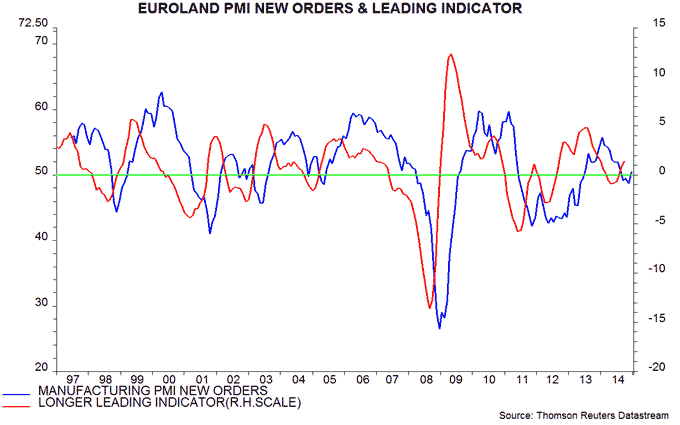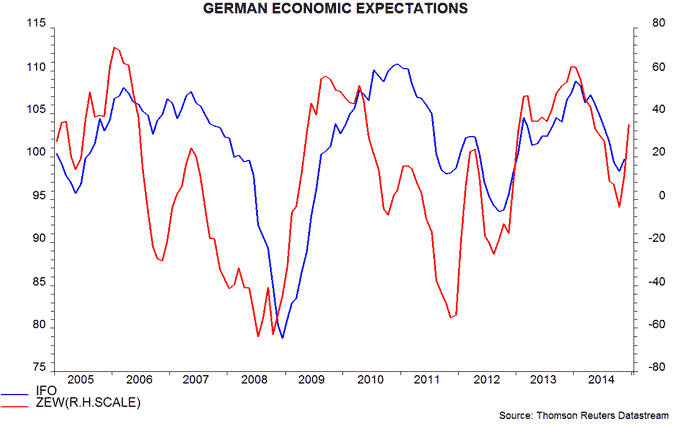Entries from December 14, 2014 - December 20, 2014
Fed 2015 / ECB 2011 comparison flawed
Paul Krugman recently drew a parallel between the Federal Reserve’s plans to raise interest rates in 2015 and the ECB’s ill-fated 2011 policy tightening, which was swiftly followed by a recession. The monetary context is different, however, casting serious doubt on the comparison.
Former ECB President Jean-Claude Trichet bears the unfortunate distinction of having raised rates on two separate occasions in the teeth of an oncoming recession – August 2008 and April / July 2011 (a double increase). These decisions were astonishing from a monetarist perspective because they were taken against the backdrop of a contracting real (i.e. inflation-adjusted) money supply, as measured by the narrow M1 aggregate – see chart. The associated recessions, in other words, would have occurred anyway but were certainly magnified by the ECB’s actions.
US real M1 growth has fallen back since mid-2014 but remains at a respectable level. A pick-up around end-2013 signalled economic strength in mid-2014 – GDP is currently estimated to have grown at a 4.2% annualised rate in the second and third quarters, although this partly reflects payback for a weak start to the year. The recent real M1 slowdown may herald a moderation in GDP expansion to a 2-3% pace. Monetary trends would need to weaken significantly further to suggest economic danger from a small interest rate rise.
Professor Krugman’s worries, therefore, are premature. The ECB, meanwhile, may be repeating its 2008 / 2011 mistakes in reverse, with President Draghi and his allies seemingly determined to push through sovereign QE in early 2015 despite recent strong monetary growth and building evidence of an economic upswing.

UK pay pick-up suggesting tight labour market
Today’s UK labour market statistics cast doubt on the MPC majority forecast of a slow recovery in pay growth accompanied by improved productivity performance. Private sector regular earnings rose by 2.3% in the year to October, the largest annual gain since March 2012. Earnings in the latest three months grew by 4.2% annualised from the previous three.
Aggregate hours worked, meanwhile, rose by 0.7% in the three months to October from the previous three, suggesting that a slowdown during the summer was noise rather than indicative of a step-up in underlying productivity growth.
Earnings acceleration is consistent with historical evidence of a lagged relationship with job openings (vacancies), discussed in a post in September. The job openings rate (i.e. vacancies as a percentage of filled and unfilled jobs) rose further in the three months to November, moving closer to its 2008 peak – see chart.
The current commodities-driven plunge in headline CPI inflation is obscuring a pick-up in domestic cost pressures, evidenced by a faster rise in the gross value added (GVA) deflator as well as higher pay growth. Today’s MPC minutes made no mention of the increase in annual GVA inflation to 2.3% in the third quarter, a two-year high – see previous post. Complacent policy-makers may be sowing the seeds of another inflation overshoot.

Eurozone surveys firming on schedule
Eurozone business surveys are starting to confirm the improved economic outlook signalled by monetary trends and leading indicators – see previous post.
The Eurozone manufacturing purchasing managers’ new orders index rose back above the breakeven 50 level in December after three months below it. This turnaround has occurred on schedule following a recovery in the longer leading indicator calculated here from a low in May – see first chart.
The December ZEW survey, meanwhile, reported a further solid gain in German economic expectations, which should be mirrored directionally by the more widely-watched Ifo survey released on Thursday – second chart.
These improvements are unlikely to deflect ECB President Draghi from attempting to drive through sovereign QE in early 2015. His hand has been strengthened by modest take-up of last week’s TLTRO2 lending operation. As the table shows, the TLTRO2 loan was less than half that required to offset the repayment of earlier three-year LTRO loans by end-February 2015. With private sector asset purchases unlikely to fill the gap, the balance sheet may contract slightly in early 2015, casting further doubt on the achievability of the ECB’s “intended” expansion of about €1 trillion on a reasonable time scale without sovereign QE.
| € billions | |
| Longer-term refinancing operations | |
| TLTRO2 Dec-14 | 130 |
| Repayment of three-year LTROs from 2011-12 by Feb-15 | -271 |
| Implied net change by Feb-15 | -141 |
| Covered bond / ABS purchases | |
| Addition by Feb-15 assuming €5 billion per week | 60 |
| Combined impact by Feb-15 | -81 |



